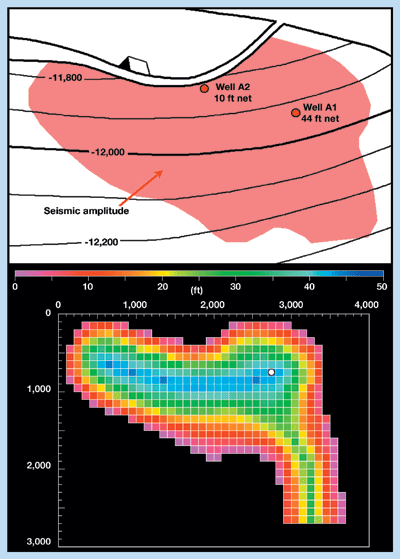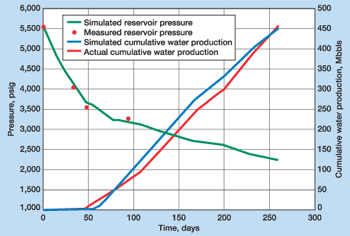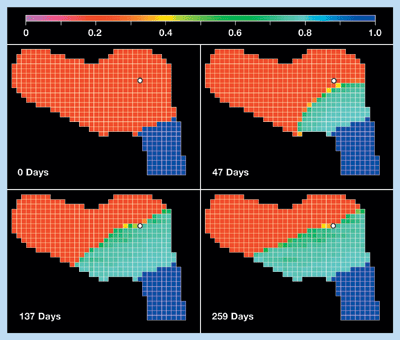Producing partial waterdrive gas reservoir at high rate maximizes profitability
Producing partial waterdrive gas reservoir at high rate maximizes profitabilityDana Westphal, Ocean Energy, Lafayette, La.; and John McMullan, Louisiana State University, Baton Rouge, La., [jmcmul2@lsu.edu] Bottom line. Ocean Energy achieved a 70% recovery and maximized profitability from a downdip waterdrive gas completion by aggressively producing the zone at high rates. Simulation confirmed that high production rates were not detrimental to recovery in this partial waterdrive gas reservoir, allowing accelerated project pay-out. Completing the entire interval also yielded the highest ultimate recovery. The reservoir was efficiently depleted from a single wellbore in spite of its downdip location. Field background. The Z sand gas reservoir in a field located in the Eugene Island area, central Gulf of Mexico shelf, was discovered and delineated with the drilling of the A1 and A2 wells in 1997. Well A1 encountered 44 net ft of high-porosity, fine-grained sandstone at a depth of 11,932 ft subsea. The A2 encountered 10 net ft of gas sand at a depth of 11,835 ft subsea. The Z sand gas reservoir was normally pressured with a condensate yield of about 60 bbl/MMcf. Well A1, completed in the entire 74-ft gross interval, was placed on production in November 1997 after perforating and frac-packing. Following clean-up, the well was produced at maximum possible rate through 3-1/2-in. tubing, peaking at more than 50 MMcfd. Production was essentially water-free for about six weeks, before rates began to fall with significant water production. By August 1998, with dropping pressure and increasing water, the well would no longer flow. Significant water production confirmed the existence of a partial waterdrive. Production from well A1 totaled 3.2 Bcf gas, 200 Mbo and 533 Mbw during its nine-month life. After losing well A1, a recompletion from a shallower sand to the Z sand was attempted in well A2 without success. A study then was undertaken to determine:
Z sand reservoir study. In reservoirs like the Z sand, questions arise as to whether elevated production rates result in water coning and premature abandonment. One recent study (SPE paper 58983, "Optimization of Gas-Well Completion and Production Practices") concluded that "analysis of the impact of perforated interval length indicates that ultimate gas recovery is never detrimentally impacted with increased length. Ultimate water production can be expected to increase in high permeability systems, however." The authors further concluded that "elevating gas rates should also never detrimentally impact ultimate recovery. In lower permeability systems, increasing rate was found to significantly improve ultimate recovery." This behavior is attributed to gas’s higher mobility. The Z sand reservoir study employed both material balance analysis and reservoir simulation. Although an incomplete pressure history hampered material balance analysis, it did suggest the presence of a limited, high productivity aquifer. Reservoir simulation was undertaken to provide a more complete understanding of reservoir / well behavior. While only two penetrations were available for well control, 3-D seismic data provided a reliable structural / stratigraphic representation that defined a reservoir extent of about 110 acres and provided a net thickness isopach, see Fig. 1. Productive area was about 110 acres. Aquifer support was from the southeastern edge.
The simulation model utilized ten vertical layers and 40 x 27 square grids in the horizontal direction. Radial grid refinement was utilized to allow the rigorous modeling of water coning in the grid blocks penetrated by Well A1. History matching was accomplished primarily by varying the size and productivity of the aquifer. The final history match (Fig. 2) indicated an initial gas-in-place of 4.7 Bcf, of which nearly 70% was recovered.
Water movement at different times is illustrated in Fig. 3. The upper left panel indicates the initial water saturation in the top-most layer. The upper right panel indicates that water is approaching the well after only 47 days. After 137 days (lower left panel), water has actually moved past Well A1 in some areas, but the gas-water contact is deformed into the well as the more mobile gas cusps into the wellbore. This is consistent with field observations.
Returning the well to production after unavoidable shut-ins became increasingly more difficult, with gas-lift being required to re-establish production. The lower right panel shows water distribution at abandonment. A pulsed neutron log run after production ceased showed no indication of remaining producible gas. The impact of production rate on recovery was analyzed by simulating performance with rates between 10 and 50 MMcfd, other data being held constant. Results indicated that both cumulative gas and water production from Well A1 was not affected by production rate. Thus, high production rates, intended to take advantage of seasonal market conditions, did not detrimentally impact ultimate recovery. In fact, higher revenues and reduced operating expenses, due to shorter well life, improved project profitability. Impact of the perforated interval was studied by varying the perforations between 20% and 100% of the total thickness. All runs assumed a maximum rate of 20 MMcfd. Gas recovery and water production decreased slightly as the perforated interval was shortened, and productive life was significantly increased. Limiting the perforated interval to the top of the productive zone would clearly not have had the intended effect of reducing water production and increasing ultimate gas recovery. Conclusions. A reservoir simulation study determined that ultimate recovery from the Z sand partial waterdrive gas reservoir was insensitive to production rate. This indicates that high production rates, which took advantage of market conditions, did not have a detrimental impact on recovery and, in fact, improved project profitability. Furthermore, it was determined that perforating a shorter interval would not have delayed or reduced the ultimate water production from the reservoir, but could instead have resulted in a slight reduction in ultimate recovery. Finally, it was determined that Well A1 efficiently depleted the Z sand reservoir in spite of its downdip location in this partial waterdrive reservoir. Insufficient reserves remain to justify an expensive side-track of Well A2. PTD Acknowledgment Jeff Fooshee (now with Bass Enterprises) and Brian Lively (now with ExxonMobil) are acknowledged for their technical efforts while students in petroleum engineering at LSU. Ocean Energy, Inc., is appreciated for releasing data, and Schlumberger Geoquest for use of the Eclipse reservoir simulator.
|
|||||||||||||||||||||||
- Applying ultra-deep LWD resistivity technology successfully in a SAGD operation (May 2019)
- Adoption of wireless intelligent completions advances (May 2019)
- Majors double down as takeaway crunch eases (April 2019)
- What’s new in well logging and formation evaluation (April 2019)
- Qualification of a 20,000-psi subsea BOP: A collaborative approach (February 2019)
- ConocoPhillips’ Greg Leveille sees rapid trajectory of technical advancement continuing (February 2019)





